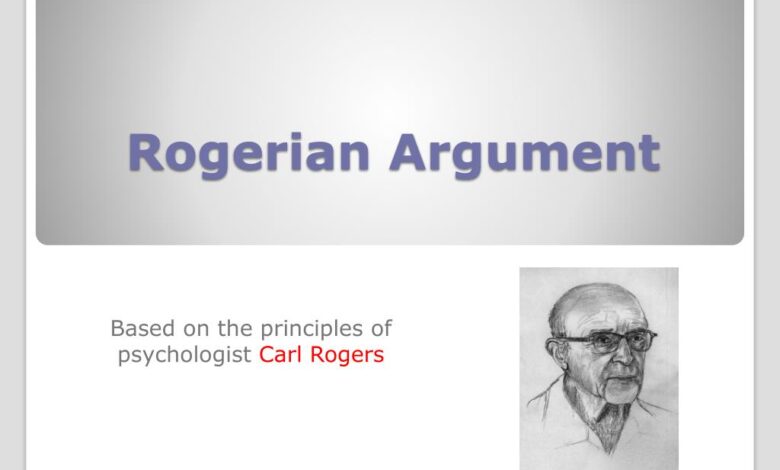Rogerian Argument: Definition and Examples

The Rogerian argument could be a negotiating strategy during which common goals square measure known ANd opposing views square measure represented as objectively as doable in an attempt to ascertain footing and reach an agreement. it’s additionally referred to as Rogerian rhetoric, Rogerian argumentation, Rogerian persuasion, and sympathetic listening.
Whereas ancient argument focuses on winning, the Rogerian model seeks a reciprocally satisfactory answer.
The Rogerian model of argument was custom-made from the work of yank scientist Rogers by the composition students Richard Young, Alton Becker, and Kenneth Pike in their textbook “Rhetoric: Discovery and Change” (1970).
Aims of Rogerian Argument
The authors of “Rhetoric: Discovery and Change” make a case for the method this way:
“The author WHO uses the Rogerian strategy makes an attempt to try to 3 things: (1) to convey to the reader that he’s understood, (2) to delineate the realm inside that he believes the reader’s position to be valid, and (3) to induce him to believe that he and also the author share similar ethical qualities (honesty, integrity, and goodwill) and aspirations (the need to get a reciprocally acceptable solution).
We stress here that these square measure solely tasks, not stages of the argument. The Rogerian argument has no standard structure; indeed, users of the strategy deliberately avoid standard persuasive structures and techniques as a result of these devices tend to provide a way of threat, exactly what the author seeks to beat…
“The goal of Rogerian argument is to make a state of affairs causative to cooperation; this might well involve changes in Format of Rogerian Argument.
When presenting your case and also the case of the opposite aspect, the fashion is versatile with however you established your info and the way long you pay on every section. however you are doing wish to be balanced—spending AN unreasonable quantity of your time on your position and solely giving pretense to the opposite aspect, as an example, defeats the aim of victimization the Rogerian vogue. the perfect format of a written Rogerian persuasion appearance one thing like this (Richard M. Coe, “Form and Substance: a sophisticated Rhetoric.” Wiley, 1981):
Introduction: gift the subject as a tangle to resolve along, instead of a problem.
Opposing position: State the opinion of your opposition in AN objective manner that is honest and correct, that the “other side” is aware of that you just perceive its position. The context for the opposing position: Show the opposition that you just perceive underneath what circumstances its position is valid.
Your position: gift your position objectively. Yes, you wish to be convincing, however, you wish the opposition to envision it with clarity and fairly furthermore, even as you have given its position earlier. The context for your position: Show the opposition contexts during which your position is additionally valid.
Benefits: charm to the opposition and show however components of your position may work to profit its interests.
You use one kind of rhetoric once discussing your position with people that already accept it as true with you.
to debate your position with the opposition, you wish to tone that down and break it into objective components, that the sides will additionally simply see areas of footing. Taking the time to state the opposing side’s arguments and contexts suggests that the opposition has less reason to urge defensive and stop being attentive to your concepts.
Feminist Responses to Rogerian Argument
In the Nineteen Seventies and into the first Nineties, some dialogue existed concerning whether or not girls ought to use this conflict-solving technique.
“Feminists square measure divided on the method: some see Rogerian argument as feminist and helpful as a result of it seems less antagonistic than ancient Aristotelian argument.
Others argue that once utilized by girls, this sort of argument reinforces the ‘feminine’ stereotype since traditionally girls square measure viewed as nonconfrontational and understanding (see particularly Catherine E. Lamb’s 1991 article ‘Beyond Argument in Freshman Composition’ and Phyllis Lassner’s 1990 article ‘Feminist Responses to Rogerian Argument’).” (Edith H. Babin and Kimberly Harrison, “Contemporary Composition Studies: A Guide to Theorists and Terms.” timberland, 1999).




